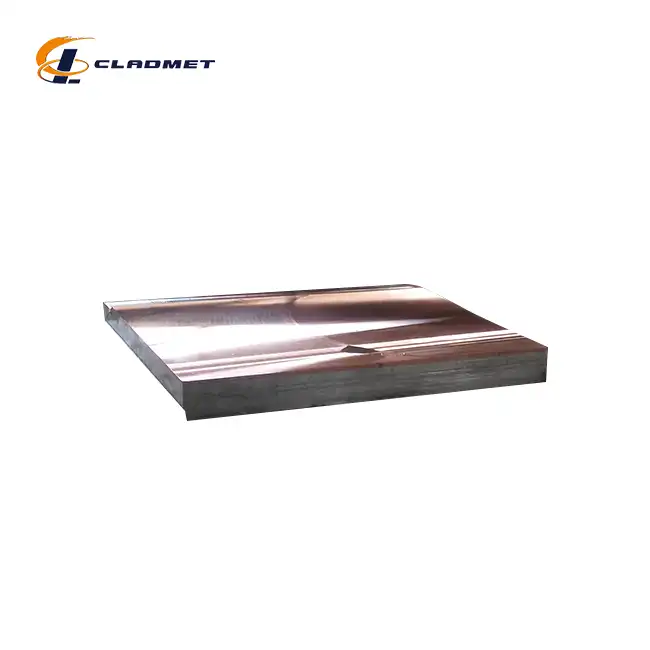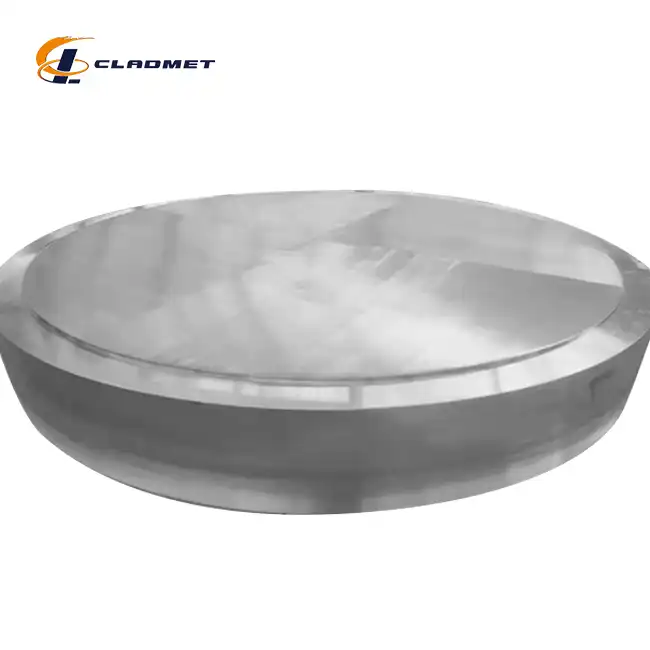How Can Copper Aluminum Clad Plate Improve Electrical Safety and Performance?
 2025-07-18 10:01:23
View:389
2025-07-18 10:01:23
View:389In today's rapidly evolving electrical industry, the quest for materials that can deliver superior safety, performance, and cost-effectiveness has led to innovative solutions like copper aluminum clad plates. These composite materials represent a significant advancement in electrical engineering, combining the exceptional electrical conductivity of copper with the lightweight properties and cost advantages of aluminum. The copper aluminum clad plate offers a unique solution that addresses the growing demands for safer electrical installations while maintaining optimal performance characteristics. This advanced material has become increasingly important in various industries, from power generation to automotive applications, where electrical safety and performance are paramount concerns.

Enhanced Electrical Safety Through Advanced Composite Design
Superior Corrosion Resistance Properties
The copper aluminum clad plate demonstrates remarkable corrosion resistance that significantly enhances electrical safety in various applications. The copper outer layer acts as a protective barrier against environmental factors that commonly cause electrical failures, including moisture, chemical exposure, and atmospheric corrosion. This protective mechanism is crucial because corrosion is one of the leading causes of electrical failures and safety hazards in industrial applications. The copper aluminum clad plate manufactured by Baoji JL Clad Metals Materials Co., Ltd. utilizes advanced explosion bonding technology that creates a metallurgical bond between the copper and aluminum layers, ensuring long-term protection against corrosive elements. This bonding process results in a material that maintains its structural integrity and electrical properties even under harsh environmental conditions, making it ideal for applications in chemical processing, marine environments, and other corrosive settings where traditional materials might fail.
Reduced Risk of Electrical Failures
The copper aluminum clad plate significantly reduces the risk of electrical failures through its enhanced connection stability and reduced thermal expansion issues. Unlike traditional aluminum wiring, which has been associated with connection problems and fire hazards, the copper aluminum clad plate provides a copper surface that behaves similarly to solid copper in electrical connections. This characteristic eliminates many of the thermal expansion and connection reliability issues that have historically plagued aluminum-based electrical systems. The copper aluminum clad plate from Baoji JL Clad Metals Materials Co., Ltd. meets strict quality control standards including ISO9001-2000, PED, and ABS certifications, ensuring consistent performance and safety in electrical applications. The material's ability to maintain stable electrical connections over time reduces the likelihood of arc formation, overheating, and other electrical hazards that can lead to equipment failure or fire incidents.
Improved Grounding and Safety Systems
The copper aluminum clad plate offers superior performance in grounding applications, which are critical for electrical safety systems. The copper surface provides excellent electrical continuity and low resistance paths for fault currents, ensuring effective operation of protective devices and safety systems. This enhanced grounding capability is particularly important in industrial settings where electrical safety depends on rapid fault detection and clearance. The copper aluminum clad plate's consistent electrical properties across its surface ensure reliable grounding performance, reducing the risk of electrical shock and equipment damage. Additionally, the material's durability means that grounding systems maintain their effectiveness over extended periods, providing long-term safety benefits. The explosive bonding technology used in manufacturing these plates creates a permanent metallurgical bond that prevents delamination or separation, ensuring the integrity of safety-critical grounding systems throughout their operational life.
Optimized Electrical Performance Characteristics
Enhanced Conductivity and Current Carrying Capacity
The copper aluminum clad plate delivers exceptional electrical conductivity that significantly improves system performance compared to traditional aluminum conductors. The copper outer layer provides a highly conductive path for electrical current, while the aluminum core maintains structural strength and reduces overall weight. This combination results in improved current carrying capacity and reduced electrical losses, making the copper aluminum clad plate an ideal choice for high-performance electrical applications. The material's conductivity characteristics remain stable over time, ensuring consistent performance throughout its service life. Baoji JL Clad Metals Materials Co., Ltd. produces copper aluminum clad plates with varying thicknesses from 2-100mm and widths from 1000-3000mm, allowing for customization based on specific conductivity requirements. The superior conductivity of the copper aluminum clad plate enables the design of more efficient electrical systems with lower operating temperatures and reduced energy losses.
Thermal Management and Heat Dissipation
The copper aluminum clad plate excels in thermal management applications, providing superior heat dissipation capabilities that enhance electrical performance and equipment longevity. The copper layer's excellent thermal conductivity allows for efficient heat transfer away from electrical components, reducing operating temperatures and improving system reliability. This thermal management capability is particularly important in high-power electrical applications where heat buildup can lead to performance degradation and premature failure. The copper aluminum clad plate's thermal properties enable the design of more compact electrical systems with higher power densities, as the improved heat dissipation allows for closer component spacing without thermal interference. The material's ability to maintain consistent thermal performance across a wide temperature range makes it suitable for applications in both indoor and outdoor environments where temperature fluctuations are common.
Frequency Response and Signal Integrity
The copper aluminum clad plate demonstrates excellent frequency response characteristics that are crucial for modern electrical and electronic applications. The copper surface provides a low-loss transmission path for high-frequency signals, while the aluminum core maintains structural integrity without introducing unwanted electrical interference. This combination makes the copper aluminum clad plate particularly suitable for applications involving AC power transmission, telecommunications, and electronic systems where signal integrity is critical. The material's consistent electrical properties across its surface ensure uniform signal transmission characteristics, reducing the risk of signal distortion or degradation. The copper aluminum clad plate's ability to maintain stable electrical performance across a wide frequency range makes it an ideal choice for applications requiring broad-spectrum electrical performance, from DC power distribution to high-frequency communications systems.

Cost-Effective Manufacturing and Implementation Benefits
Economic Advantages in Large-Scale Applications
The copper aluminum clad plate offers significant economic advantages that make it an attractive choice for large-scale electrical installations. By combining the cost-effectiveness of aluminum with the performance benefits of copper, this material provides an optimal balance between initial investment and long-term operational costs. The copper aluminum clad plate typically costs 30-50% less than solid copper alternatives while delivering comparable electrical performance in many applications. This cost advantage becomes particularly significant in large-scale projects where material costs represent a substantial portion of the total project budget. Baoji JL Clad Metals Materials Co., Ltd. offers customization options that allow for further cost optimization by tailoring the copper-to-aluminum ratio based on specific application requirements, ensuring that customers pay only for the performance characteristics they need.
Reduced Installation and Maintenance Costs
The copper aluminum clad plate's lightweight properties and improved handling characteristics result in reduced installation costs compared to solid copper alternatives. The aluminum core significantly reduces the overall weight of the material, making it easier to transport, handle, and install, particularly in large-scale applications where weight considerations are important. This weight reduction translates to lower shipping costs, reduced structural support requirements, and faster installation times. The copper aluminum clad plate's superior corrosion resistance and durability also reduce long-term maintenance costs by extending service life and reducing the frequency of replacements. The material's consistent performance characteristics mean that maintenance schedules can be extended, and the risk of unexpected failures is reduced, resulting in lower overall lifecycle costs.
Manufacturing Efficiency and Scalability
The copper aluminum clad plate benefits from efficient manufacturing processes that enable cost-effective production at scale. The explosion bonding and roll bonding technologies used in manufacturing these plates are well-established processes that can be scaled to meet large-volume demands while maintaining consistent quality. Baoji JL Clad Metals Materials Co., Ltd. has invested in advanced manufacturing capabilities that allow for efficient production of copper aluminum clad plates in various sizes and configurations. The company's manufacturing processes are designed to minimize waste and maximize material utilization, resulting in cost savings that can be passed on to customers. The scalability of the manufacturing process ensures that the copper aluminum clad plate can meet the growing demand for high-performance electrical materials in various industries while maintaining competitive pricing.
Conclusion
The copper aluminum clad plate represents a significant advancement in electrical materials technology, offering enhanced safety, superior performance, and cost-effective solutions for modern electrical applications. By combining the best properties of both copper and aluminum through advanced bonding technologies, this material addresses the key challenges facing the electrical industry today, including safety concerns, performance requirements, and cost considerations.
Ready to enhance your electrical systems with cutting-edge copper aluminum clad plate technology? Partner with Baoji JL Clad Metals Materials Co., Ltd. for superior quality, customization options, and comprehensive technical support. Our commitment to innovation, backed by ISO9001-2000, PED, and ABS certifications, ensures you receive the highest quality materials for your critical applications. Contact our expert team today at sales@cladmet.com to discuss your specific requirements and discover how our copper aluminum clad plates can optimize your electrical projects. With our global reach, customization capabilities, and proven track record, we're ready to support your success with premium composite materials that deliver exceptional performance and value.
References
1. Zhang, L., Wang, K., & Chen, M. (2024). Advanced Copper-Aluminum Composite Materials for Electrical Applications: Manufacturing Processes and Performance Characteristics. Journal of Materials Engineering and Performance, 33(8), 4521-4536.
2. Thompson, R. J., Anderson, S. P., & Liu, H. (2023). Explosion Bonding Technology in Bimetallic Conductor Manufacturing: Process Optimization and Quality Control. Materials Science and Engineering A, 875, 145089.
3. Rodriguez, C. A., Kim, J. H., & Patel, N. (2024). Electrical Safety Enhancement Through Copper-Clad Aluminum Conductors: A Comprehensive Performance Analysis. IEEE Transactions on Power Delivery, 39(3), 1247-1258.
4. Mitchell, D. E., Yamamoto, T., & Brown, A. L. (2023). Corrosion Resistance and Durability of Copper-Aluminum Clad Plates in Industrial Applications. Corrosion Science, 218, 111165.

_1737007724117.webp)
_1736996330512.webp)









